With a new year, many people are focused on new resolutions, or the revival of old resolutions that were cast to the wayside at some point in the last year or years. This month’s Canadian Food Experience Challenge focuses on resolutions, and when it comes to food resolutions, the one I’ve made (and broken) the most often over the past couple years is to make my own bread.
The Canadian Food Experience Challenge began June 7, 2013, and as we (participants) share our collective stories through our regional food experiences, we hope to bring global clarity to our Canadian culinary identity. Whenever I make homemade bread I feel tied to my immigrant settler roots, where there was no other way to have bread than to make it, and where people with far less leisure time than me had bread making as part of their regular routine. Living in a country where gorgeous golden wheat fields abound, I wish good bread was a staple part of everyone’s diet, as unpopular as that is quickly becoming. I love everything about fresh homemade bread, from crusty sourdough to soft rosemary foccacia to regular sandwich bread to sweet banana bread.

Photo from http://wakpaper.com/id158448/wheat-field-free-wallpapers-28621-1920×1200-pixel.html
This year, I’m determined to make my own bread at least 80% of the time, and I believe it’s possible because I started executing this goal a couple months ago, in the middle of a busy school semester, and no such busyness lies in my foreseeable future, so there is NO excuse this time.
What finally worked to get me making my own bread regularly?
I just simply stopped buying bread. When you decide good bread is too expensive, and the ingredient list is too long, and you think about how fantastic fresh homemade bread looks, smells, and tastes, it’s not that hard. Making bread takes very little hands-on time, and now that I’m home full time I know I have more than enough time.
The hardest part about the commitment was finding THE bread recipe, the one I could make all the time, that would work every time, that made every minute of work worth it. I have a quick rise bread I make regularly because I am a creature of poor planning, but I wanted a regular go-t0 homemade sandwich bread that worked every time. I had plenty of flat, lopsided, and dense loaves in the course of this experimentation.
I know that consistency in yeast baking is all about things that are totally my own fault, like adequate but not excessive rising time, water of the right temperature to get friendly with the yeast but not kill it, and sugar added before salt and fat so the yeast doesn’t feel inhibited, but I want a bread recipe that works for me and my approach to baking. When I see “spoon and level flour” written like it’s some kind of rule, I laugh. I’ve never spooned or leveled flour in my life. I scoop it straight out of the bag with my measuring scoop, shake it a little, and dump it in. I’m doin’ just fine.
After several failed or mediocre attempts, I eventually did what I should have done first: asked some trusted friends. Two friends recommended the same recipe, so I knew it had to be good, and it was: THIS is now the bread recipe I use every time for our regular, everyday bread, and it is amazing. It rises SO nice and high, the texture is perfect even when it’s toasted from the freezer, the water temperature isn’t too picky, and I can substitute more than half of the all purpose flour with whole wheat bread flour without it being any less perfect!
The Molasses & Oat Bread I’m sharing today is another bread I have found to be very forgiving of my imperfect approach to bread (and yes, life), and it’s a great option to have in the bread rotation. It’s healthy, full of flavour, a lovely rich colour from the molasses, and perfect with things like cheese, egg salad, and jam. It also happens to rise beautifully, and toast as well as any store bought bread.
One thing I’ve learned in bread making so far is the importance of not adding too much flour. Just as overmixing your muffin batter will give you tough muffins, so adding too much flour will give you tough, dry bread. This is where a stand mixer is great because you can leave it stickier and just scrape it out into your rising bowl with a spoon when the kneading is done. If you’re doing it by hand, a great trick is to knead in a large bowl lightly coated with cooking spray and flour. Dough sticking to a bowl is much less problematic than dough sticking to your counter and you’re less likely to add too much flour.
Baking at high elevations is a whole ‘nother story, and you’re on your own there. Sorry.
Between this molasses oat bread, my quick rise bread, and my new go-to sandwich bread, I feel like this resolution is doable. It’s even more doable since we aren’t actually huge bread eaters – we usually have a stash of muffins, scones, pancakes, or waffles kicking around in the freezer. However, good bread is still a necessity in our house for under fried eggs, made into grilled cheese or grilled chocolate strawberry sandwiches, or turned into French toast. I hope my parents don’t mind homemade bread because I plan to be using their oven often while I’m there :)
The next step in the resolution is the rest of the bread products. I’ve done homemade bagels and LOVED them, but somehow never got around to doing it again. Same thing for homemade soft pretzels. Then there are amazing recipes for English muffins, and those and homemade tortillas have been on my kitchen bucket list for aaages.
Which bread product does your family consume the most of, and which are you most (or least!) likely to make at home?
- 1¼ cups boiling water
- ¾ cup large-flake rolled oats
- ⅓ cup fancy molasses
- 2 tbsp butter, softened
- 1 egg, beaten
- 1 tsp granulated sugar
- ½ cup warm water
- 1 tbsp (or 1 package) active dry yeast
- 3 cups all purpose flour (approx)
- 1 cup whole wheat flour
- 1½ tsp salt
- Topping (optional):
- 1 egg, beaten
- 2 tbsp large-flake rolled oats
- In heatproof bowl, stir boiling water with rolled oats; let stand until absorbed, about 15 minutes. Stir in molasses, butter and egg.
- Meanwhile, in large bowl, dissolve sugar in warm water; sprinkle in yeast and let stand until frothy, about 10 minutes. Stir in oat mixture. Stir in 2-1/2 cups (625 mL) of the all-purpose flour, whole wheat flour and salt to form sticky dough.
- Turn out onto floured surface. Knead until smooth and elastic, adding as much of the remaining flour as necessary, about 5 minutes. Place in greased bowl, turning to grease all over. Cover with plastic wrap; let rise in warm draft-free place until doubled in bulk, about 1 hour.
- Punch down dough; divide in half with a sharp knife. On floured surface, pat each half into 11- x 8-inch (28 x 20 cm) rectangle. Starting at narrow end, roll up into cylinder; pinch edge to seal. Fit into 2 greased 8x4"or 9x5" loaf pans. Cover with damp tea towel; let rise again in warm, draft-free place until doubled in bulk, about 1 hour.
- Topping: Brush loaves gently with egg mixed with a teaspoon of water; sprinkle with oats. Bake in centre of 375°F oven until loaves sound hollow when tapped on bottoms, about 36-40 minutes. Let stand 10 minutes, then run a knife around the edges and remove to wire cooling racks to cool.
Store in airtight plastic bag at room temperature for up to 4 days, or cool, slice, and freeze for longer storage.
Adapted from Canadian Living.
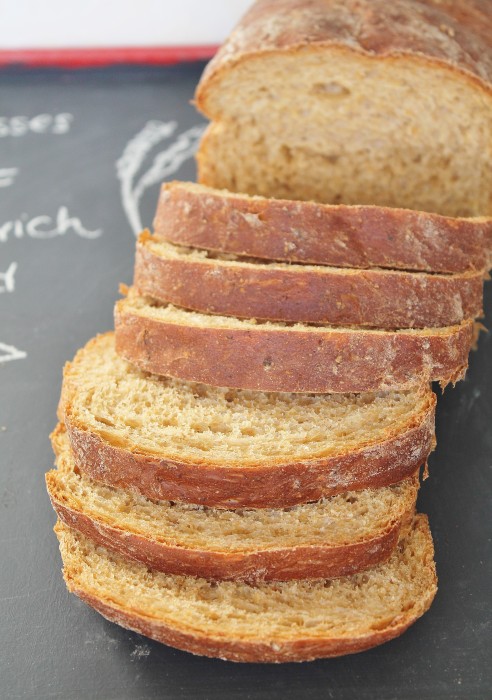
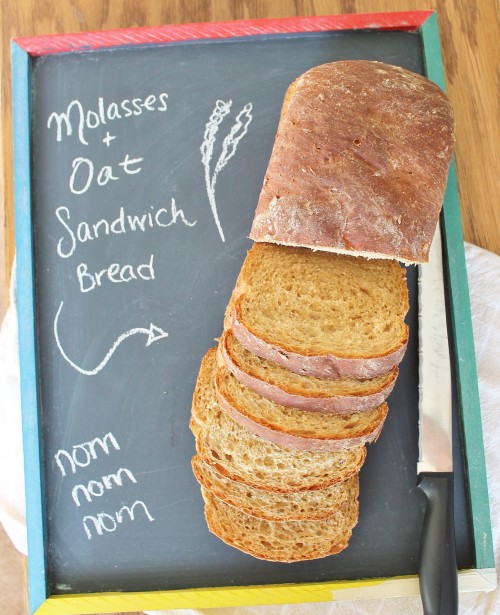


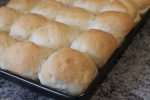

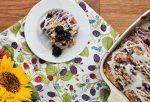
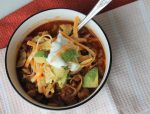
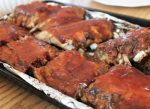
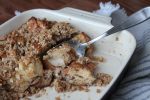
Hello at a difficult time. Are you still baking?Here in Tokyo with husband retired and adult daughter now working from home we’ve decided to try bread baking. No whole wheat flour is available (actually most stores are by now out of hard flour and canola oil as well as hoarded toilet paper/masks etc) but I have oats and molasses (left from Christmas past).
Only wish you had given measurements as is sometimes seen in Canadian recipes in ml or grams as well as cups etc .
Let’s see how my tiny Japanese oven works for bread loaves.
Thanks.
I think I’m baking more than usual, all those recipes that take a bit more time are perfect right now! Let me know how it turns out – it’s a pretty forgiving recipe so exact weights shouldn’t be necessary, and all-purpose flour works great.
Can honey be used instead of molassas?
I’ve never tried it, but I imagine the results wouldn’t be quite the same – molasses has a much deeper, less sweet flavour. If you don’t mind a sweeter bread, though, it should work.
I am just making this bread today, will let you know how it turns out. I did find however that more flour was needed when kneading due to its stickiness. It could be the flour or many other variables but one thing I know for sure is you can’t knead bread if its sticking to your fingers and palms.. I am hoping it doesn’t end up being a brick.
Anna
It is quite a sticky dough but everything from altitude to humidity can affect the flour quantity and if I can make it I consider it a pretty forgiving bread recipe, so hopefully it still works well :)
June 2025 – because I like to first read comments about a recipe I’d like to try, I came across yours today. I’m not sure you will see this, especially more than 10 years later, but it may also be helpful to someone else. Since I’ve been baking breads for almost 60 years, I would suggest a couple of options for a sticky dough.
First, once mixed, cover, and let the dough rise for 15 minutes, then gently punch it down to deflate, cover again, and repeat this every 15 minutes, three more times. Total rising time of one hour. After the 4th time, carry on with forming the loaves.
The second option is a series of “stretch and folds” to develop a sticky dough without adding additional flour. Every 15 minutes, reach under the dough and pull it up gently from the bottom on one side, stretching it out, then folding it over the top. Turn the bowl a quarter turn and repeat the “stretch and fold” all the way around the bowl. Cover and repeat the process every 15 minutes for a total of one hour hour. After the 4th time, carry on with forming the loaves.
Both these methods help develop the gluten without incorporating additional flour. Once the hour is up, it will take very little, if any, flour to shape and fold.
I accidentally added 1/2 a cup of molasses but it still turned out great!
Beautiful bread! I admire your perseverance and think this one is a resolution worth keeping!
My mom has always made her own bread, though she sticks with the basic white.
I may give this recipe a try…though it might take some tinkering because I’m at a higher altitude ;)
Oh this is a GORGEOUS bread, Anna! It is most definitely one that I would love to have every week! Love the texture. Now you’ve got me wanting to make my own bread regularly, too. Your loaf is so much better than anything I can buy at the store! : )
I totally agree with you on the ingredient list being too long on store bought bread. I stood in the bread isle the other day holding three different loaves trying to decide which was “best”. Which was to say, none of them. I should do this too. . . . Thanks for the inspiration!
Homemade bread is one of the best things in life. I bet the molasses gives it great flavor too!
Homemade bread is the best. My family won’t eat store bought anymore. I’ve made bread for years and still do. It is time consuming but so satisfying and knowing what ingredients are in it and no chemicals is very comforting. I also make several types of bread. One of the best cookbooks for bread I found is Peter Reinhart’s books. Your bread looks amazing.
Yay! You made the sandwich bread! Isn’t it AMAZING :) :) You’ve motivated me to get off my butt and make it again, it’s been a while. I did just make raisin bread yesterday, yum!
The recipe is printed out and waiting on the counter for you ;) I used to bake bread all the time, including raisin bread every weekend for a while, but my regular bread was too hit and miss so I gave up. Although I do still make raisin bread and cinnamon buns when I am in the mood and someone is going to be here to help us eat it. Just to warn you though, I eat way more bread when it is homemade! By the way, your Grandma Fletcher made the best bread ever…people would even buy it from her until the local bakery complained. Maybe you are following in her shoes. I’d better start buying bigger sizes :)!
What a great resolution! I hope you can stick with it through all the shifting your family will be doing over the next couple of months. We don’t eat a lot of bread either so maybe it’s something I could commit to. hmmm…
I’ve made english muffins before. So much fun seeing them puff up in the frying pan when you are cooking them.
Homemade bread really is the best – I stopped buying it at the store too so I would be forced to make it myself! This bread looks wonderful – I’ve never used molasses before in my bread – must try that!